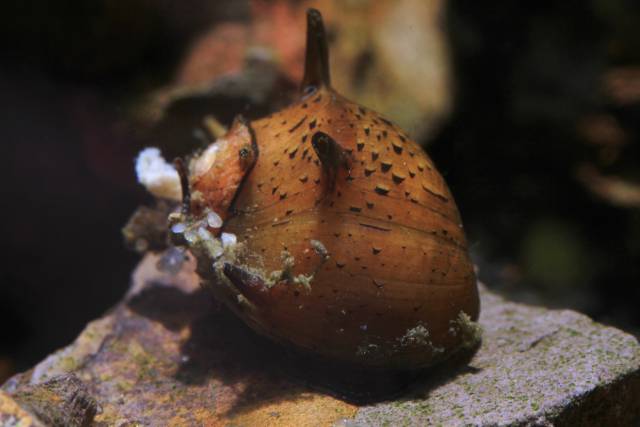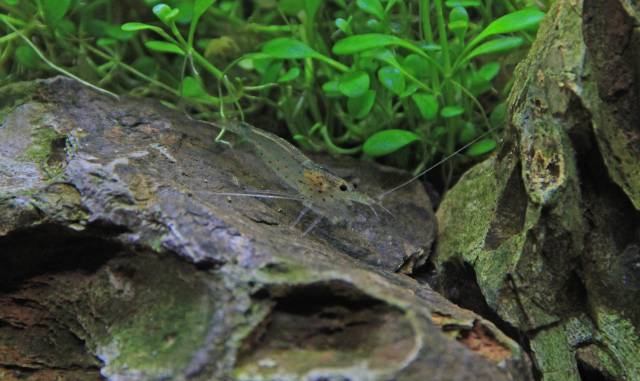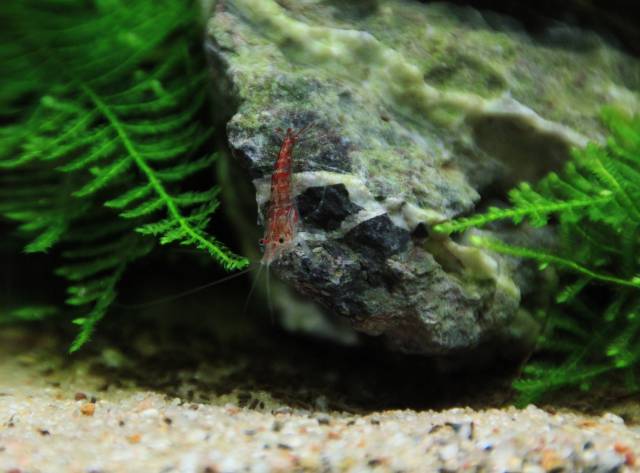They are unsightly, but they are a part of the biological system: algae in the aquarium. Especially during the time the tank needs to cycle you often have them, as the fresh ecosystem is still finding its balance.
In the following we'd like to present you some algae-eating aquarium inhabitants, mostly invertebrates like snails and shrimp. Using them has several advantages: besides algae, these animals also eat muck, food rests, dead plant parts and sometimes even dead animals. They can keep an aquarium clean, free from algae and will at the same time improve the ecological balance. Therefore, no planted tank or aquascape should be without algae-eating invertebrates.
Snails
Against green or brown algae films (diatoms, spot algae, dust algae), snails of the genera Clithon (aka sun snails) or Neritina and Vittina (often simply called nerites) are most recommendable. These snails use their rasping tongue to rid all the surfaces in the aquarium from the algae films, like the glass, the equipment and the decoration. These snails sometimes lay small white egg cocoons. The planktonic larvae that hatch from them are truly tiny. They will not develop into snails in a freshwater aquarium (they need brackish to marine water to do so). The egg cocoons are somewhat difficult to remove, unfortunately, as they are attached to the substrate quite firmly. However, they will disappear all by themselves after some time.

Clithon snails are, as a rule, a bit smaller than nerites, but they are as effective. Be wary of elevated CO2 levels in the water, especially the small sun snails are relatively susceptible to those. The larger nerites are more robust in this respect. Snails of the genus Neritina have one slight drawback, though. When grazing on the aquarium glass, they tend to go under the substrate for a bit, which may uproot newly planted ground-covering plants.
As a rule of thumb, one snail per 10 liters of aquarium volume is fine.
Please note: These snails do not survive anti-planarian treatments or algicides like AlgExit.
The so-called ramshorn snails (usually species from the genera Helisoma or Planorbella) help keeping the tank clean. They may be somewhat less efficient than the aforementioned sun snails and nerites, yet they are much more robust and colorful, and they are able to reproduce in a freshwater tank. Besides algae coats, they also known to eat short, tender filamentous algae, too.
Shrimp
When it comes to eating filamentous algae (hair algae, thread algae and fuzz algae), the most efficient shrimp is the so-called Amano shrimp (Caridina multidentata, also known under its synonymous name Caridina japonica). These shrimp are constantly busy grazing on all the surfaces in the tank, and they greatly reduce algae films on the decoration in the process. Their high activity level may have an impact on the substrate form, though. Especially in aquascapes with unplanted zones, where e.g. decorative sand is used, the activities of Amano shrimp may result in flattening-out substrate slants. To avoid this problem, plant your slanting substrate really well from day one so the plant roots stabilize the form. Sandy zones can be kept in shape with a Sand Flattener really easily.

Just like the sun snails and nerites we have mentioned above, these shrimp will not reproduce in a freshwater tank. Their larvae need brackish water to grow. Amano shrimp can reach a comparatively old age, and the females may grow to a size of a little under 6 cm. Amano shrimp are active swimmers and need a sufficiently large tank as permanent home (the recommended minimum size is a standard 60 cm aquarium with a volume of 54 liters). Moreover, they are social animals that need to be kept in a group of six or more.
As a rule of thumb, one Amano shrimp per 10 l of aquarium volume is fine. If you have more algae, for example in a cycling tank, you can temporarily double the number of Amano shrimp.

Another great choice to control algae, especially in small nano tanks, are robust dwarf shrimp like Neocaridina davidi. In contrast to Amano shrimp, they are able to reproduce in fresh water aquaria, and they ought to be kept in larger groups of 10 or more. Dwarf shrimp come in various colors (the most well-known of which probably is the red variant, often sold as Red Cherry or Red Fire), and they embellish every aquarium. Unlike Amano shrimp, they do not eat long, sturdy filamentous algae, but they love grazing on plants, the substrate and the decoration, keeping everything clean.
A sufficiently large "cleaning crew", consisting of snails and shrimp, will render your aquarium almost algae-free and makes maintenance much easier. The ecological balance in such a tank will be much more stable.